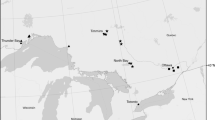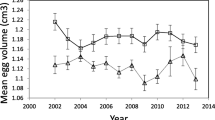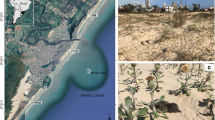Abstract
Habitat quality is generally thought to affect breeding success. We tested this effect comparing differences in clutch size and reproductive success between citril finch Serinus citrinella sub-populations closely located (<5 km) but differing in habitat quality, within the Port del Comte mountain, in the Catalonian Pre-Pyrenees. We found that birds in the low quality area (Bofia) showed significantly lower hatching, breeding and nesting success than finches in the high quality area (Vansa). These differences in reproductive success fit well with recently found differences in citril finch body mass, fat score, diet, survival rate and speed of moult between these two localities.
Similar content being viewed by others
Avoid common mistakes on your manuscript.
Introduction
Citril finches Serinus citrinella are restricted to a few mountain chains in central and south-western Europe and show a distribution pattern with more or less isolated sub-populations. Some of the highest population densities are found in the Pre-Pyrenees (Baccetti and Märki 1997). In this area, interactions of climatic conditions between the Mediterranean lowland areas and high altitudes create a striking contrast in habitat and clime between north and south facing slopes (Gutièrrez 1991), and consequently a highly heterogeneous pattern of different habitats where different habitat patches are often close together. The fact that citril finches are usually not equally distributed in their breeding areas, because they breed in ‘loose colonies’, where suitable areas between these ‘breeding groups’ can be unoccupied (Dorka 1986; Förschler 2002a), additionally promotes the typical sporadic distribution pattern of citril finches within their range.
In the Catalonian Pre-Pyrenees, notable ecological differences have been found between two sub-populations of citril finches located just about 5 km from each other within the same mountain (Port del Comte mountain). The birds at the Vansa locality show higher survival rates, body condition and speed of moult compared to the birds at the Bofia locality (Senar et al. 2002; Borras et al. 2004). They also differ in diet, with Vansa birds feeding more heavily on the highly energetic mountain pine Pinus uncinata and dandelion Taraxacum officinalis seeds than Bofia birds that feed significantly more often on thistle Cirsium eriophorum and miscellaneous herb seeds (Borras et al. 2003). Bofia faces south and is generally drier and sunnier than Vansa that faces north, is moister and cooler, and has a higher abundance of mountain pines P. uncinata (Borras and Junyent 1993; Senar et al. 2002; Borras et al. 2003, 2004). Given our current knowledge of the effect of habitat quality on breeding success and individual distribution (Newton 1998), we predict that citril finches at the Vansa locality should enjoy a higher breeding success than at Bofia.
Methods
Citril finch nests were searched for in 2002 during the nest building period (mid-April to June). One study site was on the north-facing slope (Vansa; 42°10′N, 1°32′E, ~2,060 m asl) and the other one on the south-facing slope (Bofia; 42°12′N, 1°25′E, ~1,950 m asl) of the Port del Comte mountain in the Catalonian Pre-Pyrenees (Senar et al. 2002; Borras et al. 2003, 2004). Furthermore, nests were also searched for at two localities on the east-facing slope (Prat de Botons; 42°11′N, 1°31′E, ~1,890 m asl, and Port del Comte Golfing area; 42°11′N, 1°32′E, ~1,750 m asl). The landscape of the Bofia locality is more open with large meadows and scattered mountain pine woodland, whereas Vansa is significantly stronger wooded with smaller meadows and large patches of closed forest dominated by mountain pines and few Scots pines. Habitats at Prat de Botons and the Golfing area show an intermediate position between these two extremes with open meadows and skiing areas as well as scattered mountain pine woodland and closed mountain pine forests.
Overall, 12 nests were found in the low-quality area of Bofia, 19 nests in the high-quality area of Vansa, 9 nests at the Golfing area and 20 nests at Prat de Botons. We determined clutch size, hatching and breeding success of 46 nests and nesting success of 56 nests. Nests were checked regularly (every 2–5 days) according to the known breeding course of the single nests (time of nest building, hatching and rearing period; see Förschler 2002a).
Hatching success was defined as the number of hatched birds per all found eggs in nests with clutches, and breeding success as the number of fledged young birds per all found eggs in nests with clutches (Bairlein 1996). Nesting success was defined as the number of all successful nests with at least one fledgling in relation to all nests that had been initially found (Bairlein 1996). If possible, we also determined the reasons for the nest loss, such as predation (nest destructed / eggs predated).
Results
In total, full clutches (n=46 nests) contained on the average 4.2±0.7 eggs (range 2–5 eggs). Comparing clutch size between all four localities, we did not find significant differences, but clutch size in Bofia tended to be smaller than at the other sites (Table 1). Furthermore, in Bofia, larger clutches with five eggs were more rarely observed (1 of 12 clutches) than in the other three areas where 14 of 33 clutches contained five eggs (Fig. 1).
Total hatching success of all four study areas was 56% and breeding success about 55%. Hatching success did not differ significantly between the four sites (Table 1), but citril finches at Vansa and Prat de Botons showed a significantly higher breeding and nesting success than did birds at Bofia and the Golfing area (Table 1). A comparison of Bofia and Vansa revealed a significant difference in hatching (t-test, P=0,015), breeding (t-test, p=0,009) and nesting success (Mann-Witney U-test, T=162, p=0,015).
In total, nest loss was observed in 29 out of 56 checked nests. Of these 13 nests were lost by predation, eight due to bad weather conditions and another eight by unknown reasons. Bofia showed a higher proportion of nest loss by predation than Vansa, Prat de Botons and the Golfing area (Table 2). However, the differences between Bofia and Vansa (Chi-square =0.186, df=1, P=0.186) as well as between Bofia and all other three areas (Chi-square=0.1749, df=1, P=0.186) were not significant.
Nest loss due to bad weather during the hatching period was particularly high at the Golfing area (Table 2), where several nests were abandoned due to a period of rainy and stormy weather. A Chi-square test revealed a significant difference in nest loss by weather between the Golfing area and the other three areas (Chi-square=6.155, df=1, P=0.013).
Discussion
Our results show that citril finches nesting in the high-quality area of Vansa (Senar et al. 2002) enjoyed a higher hatching, breeding and nesting success than did citril finches nesting in the low-quality area of Bofia. The results on the east-facing slopes (Prat de Botons, Golfing area) stress further that differences in breeding and nesting success can appear in the same exposition, and that areas of high and low productivity can be found in the near vicinity. Differences in hatching, breeding and nesting success between Bofia and Vansa correspond with the differences found in other studies in body mass, fat score, diet, survival rate and speed of moult between the two localities (Senar et al. 2002; Borras et al. 2004), and support the view that habitat quality strongly determines breeding success (Newton 1998). As the citril finch is known to disperse widely, naive individuals may first choose a lower quality habitat by mistake or because of concurrence, and then move on to higher quality areas to enhance their reproductive success. This kind of scenario has indeed been shown to work theoretically (Delibes et al. 2001a, 2001b) and can support a population of low quality for a long time.
Another important factor influencing breeding success is predation (Ricklefs 1969). Eurasian jays Garrulus glandarius are known to be voracious predators on songbird nests (Glutz von Blotzheim and Bauer 1993). They are also one of the most important predators on nests of citril finches (Förschler 2002b). Although differences in nest loss due to predation were not significant in our study, predation was higher in the more open area of Bofia (41.7% of all checked nests were predated) than in the three other, more closed and wooded areas (e.g. 10.5% only at Vansa). It is known that nests at forest edges are more vulnerable to predation by jays and other corvids than nests in more closed positions (Andrén 1995; Henske et al. 1999; Ibarzabal and Desrochers 2004).
Furthermore, the negative influence of bad weather as observed especially at the Golfing area, underscores that climatic conditions and therefore also timing of breeding play important roles for breeding success as well, especially in birds exposed to fast changing mountainous clime with cold spells, rain storms and snow (Frey 1989, Rauter et al. 2002).
To summarise, productivity of citril finch sub-populations fits well current models that predict an increase in breeding success with an increase in habitat quality (Newton 1998).
Zusammenfassung
Inter-lokale Variation im Reproduktionserfolg des Zitronengirlitzes (Serinus citrinella)
In den Katalonischen Vor-Pyrenäen untersuchten wir die Auswirkungen von unterschiedlicher Habitatqualität auf den Reproduktionserfolg des Zitronengirlitzes (Serinus citrinella). Dabei verglichen wir Gelegegröße, Schlupf-, Brut und Nisterfolg von zwei Teil-Populationen, die an den Berghängen des Port del Comte in geringer Entfernung zueinander (5 km) bei deutlich unterschiedlicher Habitatqualität und Exposition brüten. Wie erwartet zeigten die Zitronengirlitz-Paare des Untersuchungsgebietes mit schlechterer Habitatqualität in Süd-Exposition (Bofia) signifikant geringeren Schlupf-, Brut und Nisterfolg als die Brutvögel des Gebietes mit größerer Habitatqualität in Nord-Exposition (Vansa). Diese Variationen im Reproduktionserfolg passen sehr gut zu den bereits gefundenen Unterschieden in Körpergewicht, Fettvorrat, Nahrungswahl, Lebensdauer und Mausergeschwindigkeit zwischen den Zitronengirlitz-Populationen der beiden Gebiete und bestätigen die Hypothese, dass der Bruterfolg mit steigender Habitatqualität zunimmt.
References
Andrén H (1995) Effect of landscape composition on predation rates at habitat edges. In: Hansson L, Fahrig L, Merriam G (eds) Mosaic landscape and ecological processes. Chapman and Hall, London, pp 225–255
Baccetti N, Märki H (1997) Citril Finch. In: Hagemeijer HJ, Blair MJ (eds) The EBCC atlas of European breeding birds. Poyser, London, p 711
Bairlein F (1996) Ökologie der Vögel. Fischer, Stuttgart
Borras A, Junyent F (1993) Vertebrats de la Catalunya Central. Manresa, Barcelona
Borras A, Cabrera T, Cabrera J, Senar JC (2003) The food of the Citril Finch in the Pyrenees and the role of Pinus seeds as a key resource. J Ornithol 144:345–353
Borras A, Cabrera T, Cabrera J, Senar JC (2004) Interlocality variation in speed of moult in the citril finch Serinus citrinella. Ibis 146:14–17
Delibes M, Ferreras P, Gaona P (2001a) Attractive sinks, or how individual behavioural decisions determine source-sink dynamics. Ecol Lett 4:1–3
Delibes M, Gaona P, Ferreras P (2001b) Effects of an attractive sink leading into maladaptive habitat selection. Am Nat 158:277–285
Dorka U (1986) Der Zitronengirlitz Serinus c. citrinella im Nordschwarzwald–zur Verbreitung und Habitatwahl. Orn Jh Baden-Wurttemberg 2:57–71
Förschler M (2002a) Brutbiologie des Zitronengirlitzes Serinus citrinella im Nordschwarzwald. Ornithol Beob 99:19–32
Förschler M (2002b) Predation strategy of the Eurasian Jay Garrulus glandarius and antipredator response by the Citril Finch Serinus citrinella. Rev Catalana Ornithol 19
Frey M (1989) Brutbiologie des Hänflings Carduerlis cannabina unter den Einflüssen des Gebirgsklimas. Ornithol Beob 86:265–289
Glutz von Blotzheim UN, Bauer KM (1993) Handbuch der Vögel Mitteleuropas. Bd. 14/II. Aula, Wiesbaden
Gutierrez E (1991) Climate tree-growth relationships for Pinus uncinata Ram in the Spanish Pre-Pyrenees. Acta Oecol 12:213–225
Henske EJ, Robinson SK, Brawn JD (1999) Predator activity and predation on songbird nests on forest-field edges in east-central Illinois. Landscape Ecol 14:345–354
Ibarzabal J, Desrochers D (2004) A nest predator’s view of a managed forest: Gray Jay (Perisoreus canadensis) movement patterns in response to forest edges. Auk 121:162–169
Newton I (1998) Population limitation in birds. Academic Press, San Diego
Rauter CM, Reyer H-U, Bollmann K (2002) Selection through predation, snowfall and microclimate on nest-site preferences in the water pipit Anthus spinoletta. Ibis 144:433–444
Ricklefs RE (1969) An analysis of nesting mortality in birds. Smithson Contrib Zool 9:1–48
Senar JC, Conroy MJ, Borras A (2002) Asymmetric exchange between populations differing in habitat quality: a metapopulation study on the Citril Finch. J Appl Stat 29:425–441
Acknowledgements
This study was undertaken in cooperation with the Max Planck Research Centre for Ornithology Vogelwarte Radolfzell (Prof. Dr. Peter Berthold), the Natural History Museum of Barcelona (Dr. Juan Carlos Senar) and the Department of Experimental Ecology at the University of Ulm (Prof. Dr. Elisabeth Kalko). Prof. Dr. Peter Berthold and Prof Dr. Elisabeth Kalko provided comments on the manuscript. Gratitude is also expressed to all other people involved in our work. The study was conducted with financial support from the Max Planck Research Centre for Ornithology and the University of Ulm (Landesgraduiertenförderung Baden-Württemberg).
Author information
Authors and Affiliations
Corresponding author
Additional information
Communicated by F. Bairlein
Rights and permissions
About this article
Cite this article
Förschler, M.I., Borras, A., Cabrera, J. et al. Inter-locality variation in reproductive success of the citril finch Serinus citrinella. J Ornithol 146, 137–140 (2005). https://doi.org/10.1007/s10336-005-0072-y
Received:
Revised:
Accepted:
Published:
Issue Date:
DOI: https://doi.org/10.1007/s10336-005-0072-y





